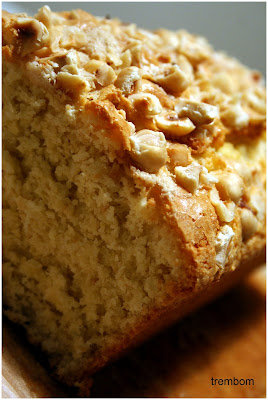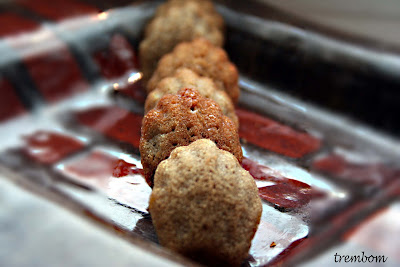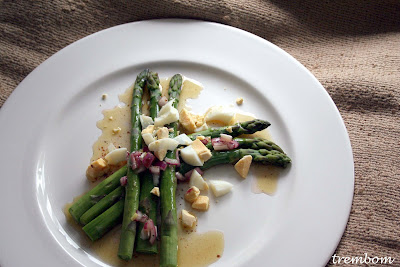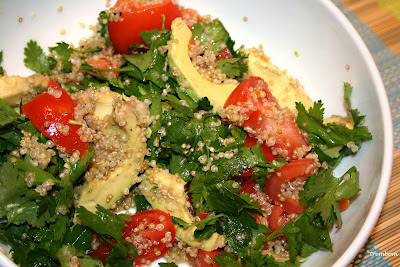

The
Daring Bakers in action once again. This time the challenge has been shared by Helen and Anita. The challenge chosen was the Gateau Saint Honore.Some very good reasons why it was chosen:
Turns out that May 16th is Saint Honore (pronounced o-no-ray) Day, patron Saint of pastry chefs and bakers. It also turns out that there is a very traditional cake named after him: Gateau Saint Honore. It is the “must pass” element of pastry school students and it is a cake that includes several elements and techniques that bakers should try at least once: puff pastry, cream puff dough, caramel and pastry filling. There are many fillings as they are bakeries: chiboust cream, pastry cream, Bavarian cream (aka Diplomat cream). The cake building goes like this: - base of puff pastry - rings of cream dough baked on top (so that the cream sticks) - cream puffs set on the pastry filling or hooked to the base with hot caramel - cream filling to fill everythingI really enjoyed this challenge. When I finished it I had a great feeling of accomplishment. I managed to laugh at my faults and made note to self to work on improving them. Most of all I felt really pleased about my accomplishments. And believe me, I am the type of person who can really focus on my mistakes. So definitely a fabulous result. The cake does not look like it should but it was my best shot. Thank you Helen and Anita for organizing and for picking the challenge.
As a piece of patisserie I don’t really like Gateau Saint Honore. I find it really busy, there is a lot going on. However, once it is broken down into parts it does give me immense pleasure – or rather, it did. The Saint Honore Cream is so delicious. I could barely stop picking on it. I followed it to the letter with the exception of the Cointreau liqueur. I had one too many spoonfuls so many times. I wonder what it will go well with since I still have some of it in the fridge. I also loved making the puff pastry because had it not been for the challenge I would not have made it anytime soon. I was always a bit scared of it. It is true that it requires a bit of elbow grease but hey..I felt good once it was done. Also had a laugh with the funny shapes of my piped dough. Need to work on that. The caramel was something else that terrified me. I foresaw, in my dramatic nature, burnt fingers and hand. In the end I did survive it and even managed to play with it at the back of a ladle.
The only thing I did not make this time was the puff pastry. As I have already made it in the past I went for the store bought one – as Helen said it was Ok.

Please accept my apologies for posting only today. Since I spilt some red wine on my key board a few months ago on top of having to buy a brand new keyboard as the other one never recovered from the trauma, I also had to deal with a laptop that would switch itself off just like that. And yesterday it did it again. All of a sudden: puff. Only difference was that this time it would not switch itself back on. I have managed to borrow a friend’s laptop today so here I am, finally posting my cake.
I would suggest you visit the other Daring Baker's sites to see their creations. The sites are listed on the bar on the right hand side.
I will post the recipe as published by Helen, with the exception of the puff pastry. Here it goes:
Pate a Choux – Cream Puffs Dough
4 ¾ oz. all purpose flour (135 gr)
1 cup water ( 240 ml)
2 oz unsalted butter (58 gr)
¼ tsp. salt (1 gr)
1 cup eggs (240 ml)
Sift the flour and set aside.
Heat the water, butter and salt to a full rolling boil, so that the fat is not just floating on the top but is dispersed throughout the liquid.
Stir the flour into the liquid with a heavy wooden spoon, adding it as fast as it can be absorbed. Avoid adding it all at once or it will form clumps.
Cook, stirring constantly and breaking up the lumps if necessary, by pressing them against the side of the pan with the back of the spoon until the mixture comes away from the sides of the pan, about 2-3 minutes.
Transfer the dough to a mixer bowl. Let the paste cool slightly so that the eggs will not cook when they are added. You can add and stir the eggs by hand but it requires some serious elbow grease.
Mix in the eggs, one at a time, using the paddle attachment on low or medium speed. Do not add all the eggs at once. Check after a few, the dough should have the consistency of thick mayonnaise.
Transfer the dough to a piping bag and use as desired.
Pate Feuillete – Puff Pastry:
Makes about 2 1/2 pounds.
3 cups all-purpose flour, plus more for work surface (420 gr)
3/4 cup cake flour (105 gr)
1 1/2 teaspoons salt (7 gr)
4 tablespoons unsalted butter, cut into 1/2-inch pieces, well chilled (60 gr)
1 1/4 cups cold water (295.5 ml)
1 tablespoon all-purpose flour (14 gr)
1 3/4 cups (3 1/2 sticks) unsalted butter, well-chilled (405 gr)
1/ Make the dough package: In a large mixing bowl, combine both flours with the salt. Scatter butter pieces over the flour mixture; using your fingers or a pastry cutter, incorporate butter until mixture resembles coarse meal.
2/ Form a well in center of mixture, and pour the water into well. Using your hands, gradually draw flour mixture over the water, covering and gathering until mixture is well blended and begins to come together. Gently knead mixture in the bowl just until it comes together to form a dough, about 15 seconds. Pat dough into a rough ball, and turn out onto a piece of plastic wrap. Wrap tightly, and place in refrigerator to chill 1 hour.
3/ Make the butter package: Sprinkle 1/2 tablespoon flour on a sheet of waxed or parchment paper. Place uncut sticks of butter on top, and sprinkle with remaining 1/2 tablespoon flour. Top with another sheet of paper; using a rolling pin, pound butter to soften and flatten to about 1/2 inch. Remove top sheet of paper, and fold butter package in half onto itself. Replace top sheet of paper, and pound again until butter is about A inch thick. Repeat process two or three times, or until butter becomes quite pliable. Using your hands, shape butter package into a 6-inch square. Wrap well in plastic wrap, and place in refrigerator until it is chilled but not hardened, no more than 10 minutes.
4/ Assemble and roll the dough: Remove dough package from refrigerator, and place on a lightly floured work surface. Using a rolling pin, gently roll dough into a 9-inch round. Remove butter package from refrigerator, and place it in the center of the dough round. Using a paring knife or bench scraper, lightly score the dough to outline the butter square; remove butter, and set it aside. Starting from each side of the center square, gently roll out dough with the rolling pin, forming four flaps, each 4 to 5 inches long; do not touch the raised square in the center of the dough. Replace butter package on the center square. Fold flaps of dough over the butter package so that it is completely enclosed. Press with your hands to seal.
5/ Using the rolling pin, press down on the dough at regular intervals, repeating and covering the entire surface area, until it is about 1 inch thick. Gently roll out the dough into a large rectangle, about 9 by 20 inches, with one of the short sides closest to you. Be careful not to press too hard around the edges, and keep the corners even as you roll out the dough by squaring them with the side of the rolling pin or your hands. Brush off any excess flour. Starting at the near end, fold the rectangle in thirds as you would a business letter; this completes the first single turn.Wrap in plastic wrap; place in refrigerator 45 to 60 minutes.
6/ Remove dough from refrigerator, and repeat process in step 5, giving it five more single turns.Always start with the flap opening on the right as if it were a book. Mark the dough with your knuckle each time you complete a turn to help you keep track. Chill 1 hour between each turn. After the sixth and final turn, wrap dough in plastic wrap; refrigerate at least 4 hours or overnight before using.
Saint Honore Cream (Rapid Chiboust or Diplomat Cream)
1 envelope unflavored gelatin (7 gr.)
1/4 cup cold water (60 ml)
1/2 cup + 2 Tablespoons sugar (130 gr)
½ cup all-purpose flour (70 gr)
1/4 teaspoon salt
5 egg yolks
2 cups whole milk (500ml)
1 Tb. rum
¼ cup whipping cream (57 gr)
3 egg whites
dash of salt
1/2 cup sugar (105 gr)
Soak the gelatin in the 1/4 cup of cold water.
Put the sugar, flour, and salt into a saucepan and stir together with a whisk. Add the yolks and enough milk to make a paste. Whisk in the remainder of the milk.
Place over low heat and stirring constantly, cook until thick. Remove from heat and stir in the vanilla and the gelatin. Stir until the gelatin is completely dissolved.
Stir in the whipping cream.Set the mixing bowl in cold water and stir until the cream is cool. Place the egg whites in a clean bowl and using clean beaters, whip them with the dash of salt. As soon as the whites begin to stiffen, gradually add the 1/2 cup of sugar and beat until they are very stiff. Fold the egg whites into the cooled cream.
Caramel:
8 oz sugar (240 gr)
Assembly:
Roll the puff pastry out to 1/8 inch (3 mm) thick, 12 inch square (30 cm). Place on a sheet pan lined with parchment paper. Refrigerate covered at least 20 minutes.
While the puff pastry is resting, make the pate a choux and place it in a pastry bag with a # 4 (8mm) plain tip. Reserve.
Leaving the puff pastry on the sheet pan, cut a 11 inch (27.5 cm) circle from the dough and remove the scraps. (An easy way to cut it is to use a 11inch tart pan as a “cookie cutter”). Prick the circles lightly with a fork.
Pipe 4 concentric rings of Pate a Choux on the pastry circle. Pipe out 12 cream puffs the size of Bing cherries onto the paper around the cake.
Bake the puff pastry circle and the cream puffs at 400F (205C) until the pate a choux has puffed, about 10 minutes. Reduce the heat to 375F (190C) and bake until everything is dry enough to hold its shape, about 35 minutes longer for the cake and 8 minutes longer for the cream puffs (just pick them up and take them out as they are done)
Place about 4 oz (114 gr) of the Saint Honore Cream in a pastry bag with a #2 (4mm) plain tip. Use the pastry bag tip or the tip of a paring knife to make a small hole in the bottom of each cream puff. Pipe the cream into the cream puffs to fill them. Refrigerate.
Spread the remaining cream filling on the cake. Refrigerate for at least 2 hours to set the cream.
Caramelize the 8 oz. of sugar:
Fill a bowl that is large enough to hold the pan used for cooking the sugar with enough cold water to reach halfway up the sides of the pan. Set the bowl aside.
Place the sugar in a heavy bottomed pan and cook until the sugar until it has caramelized to just a shade lighter than the desired color.
Remove from the heat and immediately place the bottom of the pan in the bowl of cold water to stop the cooking process.
Dip the cream puffs into the hot caramel, using 2 forks or tongues to avoid burning your fingers. Place them on a sheet pan. The caramel must be hot enough to go on in a thin layer. Reheat if necessary as you are dipping, stirring constantly to avoid darkening the caramel any more than necessary. Also, avoid any Saint Honore cream to leak out of the puffs and get mixed in with the caramel while dipping as the cream can cause the sugar to recrystallize.
Whip the one cup of heavy cream and teaspoon of sugar to stiff peaks. Place the whipped cream in pastry bag fitted with a #5 (10mm) star tip. Pipe a border of whipped cream around the top of the cake. Arrange the cream puffs, evenly spaced, on top of the filling, next to the cream.
Put it in the fridge for a couple of hours before serving.




















 I
I 
























